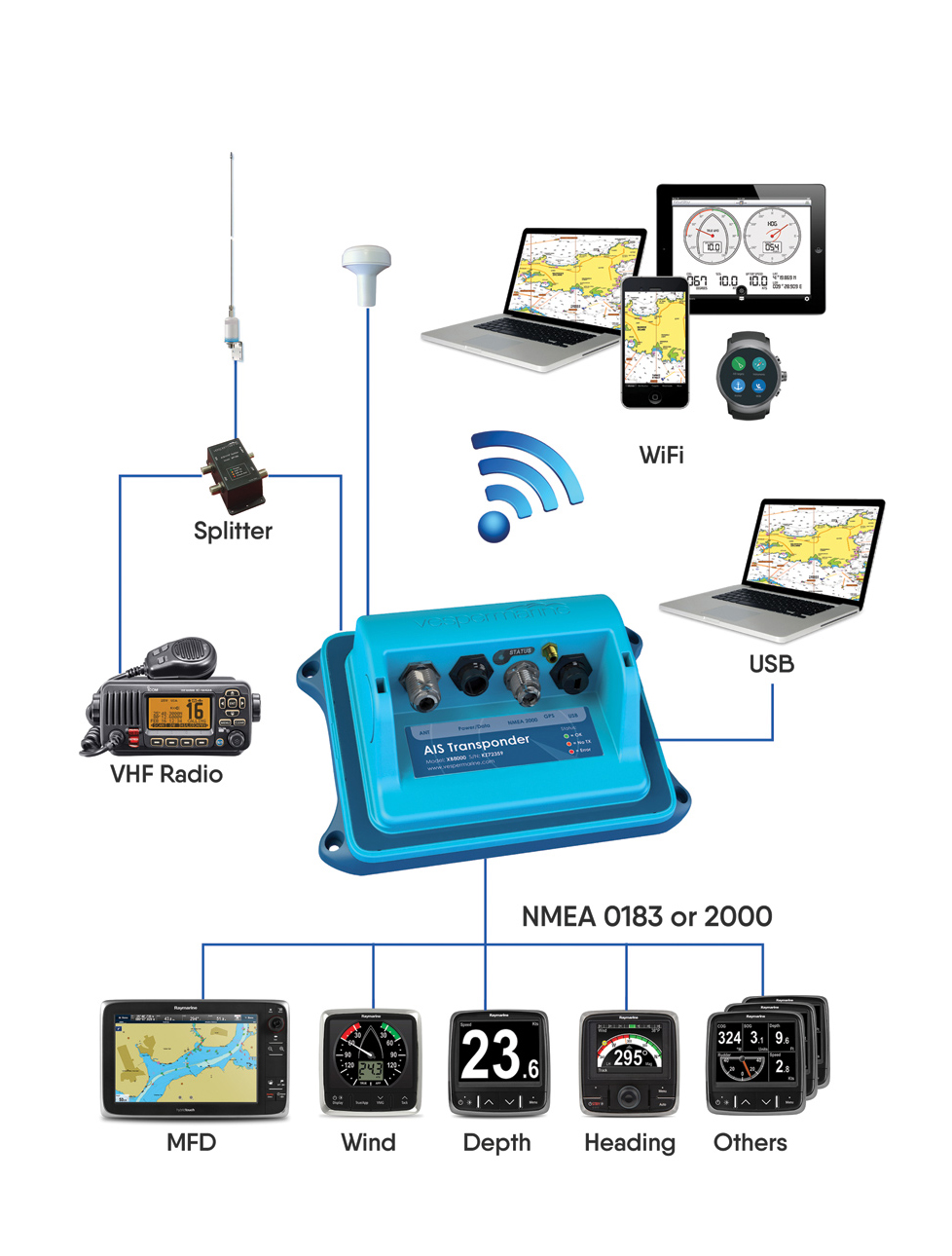For the uninitiated, AIS stands for Automatic Identification System, and that is exactly what it does. When asked about AIS, we often use the example of exchanging virtual boat “business cards” on the water. AIS information includes the vessel name, call sign, vessel size, and navigation data such as present location, course on ground (COG), and speed on ground (SOG). AIS information can be used on its own, but most often the information is displayed on your boat’s chartplotter by overlaying each AIS target’s physical location, COG, SOG, and other information in relation to your position and COG. Some chartplotters will even predict potential collisions and warn the operator.
Since AIS information is transmitted over VHF frequencies, it does better than line of sight, and commonly, AIS broadcasts can be received over low mountains or islands. Unlike radar, AIS can effectively “see” around corners. This can be a huge safety benefit in inclement weather or when navigating the many islands and passes of the Pacific Northwest, and it is a great complement to your existing radar. Also, because AIS includes the vessel’s MMSI (Maritime Mobile Service Identity) number and name, hailing a particular ship over VHF can be simplified.
AIS is a fully automated tracking system used to identify and track other vessels visually as a method of collision avoidance. Passenger ships, such as ferries and tugboats, and most large commercial vessels have a Class A transceiver (12 Watts) to send and receive AIS information on VHF frequencies. Some recreational boaters opt to transmit AIS information using a Class B transceiver (2 Watts). AIS information is free and no subscription is required. To take full advantage of AIS, all you need is a VHF or AIS antenna and AIS receiver (and/or transceiver), plus a compatible chartplotter or smartphone/tablet.

Most major chartplotter manufacturers have their own AIS components and you can explore what fits your needs. Today we are specifically going to look at the Vesper Marine WatchMate XB-8000 smartAIS transponder with Wi-Fi and an NMEA 2000 gateway. One of the unique things about this product is that you can use it even if you don’t have a chartplotter. The WatchMate App allows you to monitor navigation data and AIS and GPS alarms from your mobile device over a local Vesper Wi-Fi network. The XB-8000 will transmit your position over radio frequencies every three minutes when your speed is under 2 knots or every 30 seconds otherwise and your vessel information is transmitted every six minutes.
Installation: The Vesper WatchMate XB-8000 receiver is small, which makes it easier to interface with your chartplotter and requires minimum wire runs. Remember to write down the serial number from the unit before you install it, as this is required to set up the Wi-Fi. Let’s look at the connections required: power,
AIS/VHF antenna, and GPS.
Power: A 5’ power cable with attached 10-pin plug is supplied with the XB-8000, you may extend this cable
if necessary. When attaching the cable, ensure you fully engage the locking ring to make a watertight seal. Always use a 2-Amp fuse or circuit breaker. Do not connect directly to the battery, and if you must extend the power connections, use high quality pre-tinned marine grade wire which is at least 16 AWG (American gauge wire).
AIS/VHF Antenna or a VHF Antenna with a splitter: The AIS system uses two special “data only” channels in the VHF frequency range so almost any VHF antenna can be used to receive and transmit AIS data. The problem is that both the AIS and the VHF antenna should be installed at the highest point of the boat, however, if you choose to install two antennas they must be a minimum of 5 feet apart, otherwise all the 25-Watt power of the VHF will go directly into the AIS receiver and damage it.
If you would prefer to use your existing VHF antenna, make sure it has a vertical radiator, an antenna gain of 3 decibel (dB) or similar, and an impedance of 50 ohm. In the past, boaters preferred to install two antennas instead of an antenna and splitter because the reception was compromised on both the VHF and the AIS. That concern has been eliminated with new technology. As far as a digital splitter, we recommend the Vesper SP160 which is designed specifically for use with Vesper Marine AIS transponders. It has connections for AIS, VHF, and AM/FM radio; the Vesper digital splitter does require an external power source.
If you are a competent DIYer with basic wiring skills, this should be a six- to nine-hour installation. AIS is a great safety tool for any boat and works as a good addition to radar alone. The Wi-Fi capability allows everyone onboard to use a smart phone or tablet to follow along on the journey. Combined with the ability to transmit, it allows you to see and be seen.


